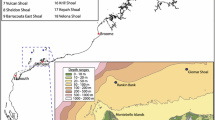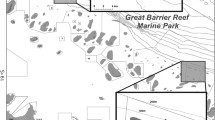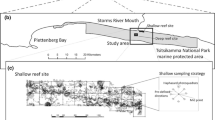Abstract
Depth and habitat are important predictors of fish assemblage structure, yet current no-take marine protected area (MPA) networks are generally limited to providing refuge for fish species that inhabit shallow waters and may exclude deep habitats essential to exploited populations. To ensure MPA efficacy at the design, uptake and management levels, baseline data on fish populations associated with deep nearshore reefs are needed. This study employed baited remote underwater stereo-video systems to investigate fish habitat associations at shallow (11–25 m) and deep (45–75 m) reef sites in the Tsitsikamma National Park MPA, South Africa. The compositions of fish assemblages at shallow and deep reef sites were significantly different. Specifically, rare species, juveniles and low trophic level species dominated the shallow reef, while deep reef assemblages were characterised by large, sexually mature and predatory fish. The body size of abundant species was also correlated with depth, with larger individuals being more abundant on deeper reefs. Habitat types were identified according to a habitat classification system established in a previous study, which resulted in four broad depth separated habitat types (defined by macrobenthos and environmental variables). Canonical analysis of principle coordinates (CAP) indicated that habitat type was a good categorical predictor of the observed fish assemblages. The CAP analysis determined that 86 % of the samples were correctly assigned to the habitat type from which they were collected, indicating that specific fish assemblages were associated with distinct habitat types. This study highlights the importance of protecting both shallow and deep reefs, not only to ensure the conservation of particular fish assemblages, but also to provide protection for all stages of the life cycle of fish species.






Similar content being viewed by others
References
Allendorf FW, Hard JJ (2009) Human-induced evolution caused by unnatural selection through harvest of wild animals. Proc Natl Acad Sci USA 106:9987–9994. doi:10.1073/pnas.0901069106
Anderson MJ, Willis TJ (2003) Canonical analysis of principal coordinates: a useful method of constrained ordination for ecology. Ecology 84:511–525
Anderson MJ, Diebel CE, Blom WM, Landers TJ (2005) Consistency and variation in kelp holdfast assemblages: spatial patterns of biodiversity for the major phyla at different taxonomic resolutions. J Exp Mar Biol Ecol 320:35–56. doi:10.1016/j.jembe.2004.12.023
Anderson MJ, Ellingsen KE, McArdle BH (2006) Multivariate dispersion as a measure of beta diversity. Ecol Lett 9:683–693. doi:10.1111/j.1461-0248.2006.00926.x
Anderson MJ, Gorley RN, Clarke KR (2008) PERMANOVA+ for PRIMER: guide to software and statistical methods. PRIMER-E ltd., Plymouth
Anderson TJ, Syms C, Roberts DA, Howard DF (2009) Multi-scale fish–habitat associations and the use of habitat surrogates to predict the organisation and abundance of deep-water fish assemblages. J Exp Mar Biol Ecol 379:34–42. doi:10.1016/j.jembe.2009.07.033
Ballantine WJ, Langlois TJ (2008) Marine reserves: the need for systems. Hydrobiologia 606:35–44. doi:10.1007/s10750-008-9347-7
Berkeley SA, Chapman C, Sogard SM (2004) Maternal age as a determinant of larval growth and survival in a marine fish, Sebastes melanops. Ecology 85:1258–1264. doi:10.1890/03-0706
Bernard A, Götz A (2012) Bait increases the precision in count data from remote underwater video for most subtidal reef fish in the warm-temperate Agulhas bioregion. Mar Ecol Prog Ser 471:235–252. doi:10.3354/meps10039
Bernard A, Götz A, Parker D et al (2014) New possibilities for research on reef fish across the continental shelf of South Africa. S Afr J Sci 110:1–5
Birkeland C, Dayton PK (2005) The importance in fishery management of leaving the big ones. Trends Ecol Evol 20:356–358. doi:10.1016/j.tree.2005.03.015
Bornt K, McLean D, Langlois TJ et al (2015) Targeted demersal fish species exhibit variable responses to long-term protection from fishing at the Houtman Abrolhos Islands. Coral Reefs 34:1297–1312. doi:10.1007/s00338-015-1336-5
Bowman A, Azzalini A (2013) R package sm: nonparametric smoothing methods, version 2.2-5
Branch G, Griffiths CL, Branch M, Beckley L (2010) Two oceans: a guide to the marine life of Southern Africa. Struik Publishers, Cape Town
Brito AC (2013) Measuring light attenuation in shallow coastal systems. J Ecosyst Ecography 03:1–4. doi:10.4172/2157-7625.1000122
Brokovich E, Einbinder S, Shashar N et al (2008) Descending to the twilight-zone: changes in coral reef fish assemblages along a depth gradient down to 65 m. Mar Ecol Prog Ser 371:253–262. doi:10.3354/meps07591
Bryars S, Rogers P, Huveneers C et al (2012) Small home range in southern Australia’s largest resident reef fish, the western blue groper (Achoerodus gouldii): implications for adequacy of no-take marine protected areas. Mar Freshw Res 63:552. doi:10.1071/MF12016
Burger LF (1990) The distribution patterns and community structure of the Tsitsikamma rocky littoral ichthyofauna. Ph.D. thesis, Rhodes University, South Africa
Buxton CD (1993) Life-history changes in exploited reef fishes on the east coast of South Africa. Environ Biol Fishes 36:47–63. doi:10.1007/BF00005979
Buxton CD, Smale M (1986) Age, growth and feeding of the blue hottentot Pachymetopon aeneum (Pisces: Sparidae) with notes on reproductive biology. S Afr J Zool 21:33–38. doi:10.1080/02541858.1986.11447953
Buxton C, Smale M (1989) Abundance and distribution patterns of three temperate marine reef fish (Teleostei: Sparidae) in exploited and unexploited areas off the Southern Cape Coast. J Appl Ecol 26:441–451. doi:10.2307/2404072
Cappo M, Harvey ES, Shortis M (2006) Counting and measuring fish with baited video techniques—an overview. In: Lyle JM, Furlani DM, Buxton CD (eds) Cutting-edge technologies in fish and fisheries science. Proceedings of Australian Society for Fish Biology Workshop, pp 101–114
Chatfield BS, Van Niel KP, Kendrick GA, Harvey ES (2010) Combining environmental gradients to explain and predict the structure of demersal fish distributions. J Biogeogr 37:593–605. doi:10.1111/j.1365-2699.2009.02246.x
Clarke KR, Gorley RN (2006) PRIMER v6: user manual/tutorial. PRIMER-E, Plymouth 192 pp
Clarke K, Warwick R (2001) Change in marine communities: an approach to statistical analysis and interpretation. Primer-E Ltd, Plymouth, UK, p 175
Colloca F, Carpentieri P, Balestri E, Ardizzone G (2010) Food resource partitioning in a Mediterranean demersal fish assemblage: the effect of body size and niche width. Mar Biol 157:565–574. doi:10.1007/s00227-009-1342-7
Crowder LB, Cooper WE (1982) Habitat structural complexity and the interaction between bluegills and their prey. Ecology 63:1802
Edgar GJ, Barrett NS, Morton AJ (2004) Patterns of fish movement on eastern Tasmanian rocky reefs. Environ Biol Fishes 70:273–284. doi:10.1023/B:EBFI.0000033342.89719.39
Edgar GJ, Stuart-Smith RD, Willis T, Kininmonth S, Baker SC, Banks S, Barrett NS, Becerro MA, Bernard ATF, Berkhout J, Buxton CD, Campbell SJ, Cooper AT, Davey M, Edgar SC, Försterra G, Galván DE, Irigoyen AJ, Kushner DJ, Moura R, Parnell PE, Shears N, Soler G, Strain EMA, Thomson RJ (2014) Global conservation outcomes depend on marine protected areas with five key features. Nature 506:216–220. doi:10.1038/nature13022
Félix-Hackradt FC, Hackradt CW, Treviño-Otón J et al (2014) Habitat use and ontogenetic shifts of fish life stages at rocky reefs in South-western Mediterranean Sea. J Sea Res 88:67–77. doi:10.1016/j.seares.2013.12.018
Fischer P (2000) Test of competitive interactions for space between two benthic fish species, burbot Lota lota, and stone loach Barbatula barbatula. Environ Biol Fishes. doi:10.1023/A:1007631107521
Fischer P, Weber A, Heine G, Weber H (2007) Habitat structure and fish: assessing the role of habitat complexity for fish using a small, semi-portable, 3D underwater observatory. Limnol Oceanogr 5:250–262. doi:10.4319/lom.2007.5.250
Fitzpatrick BM, Harvey ES, Heyward AJ et al (2012) Habitat specialization in tropical continental shelf demersal fish assemblages. PLoS One 7:e39634. doi:10.1371/journal.pone.0039634
Fitzpatrick C, McLean D, Harvey ES (2013) Using artificial illumination to survey nocturnal reef fish. Fish Res 146:41–50. doi:10.1016/j.fishres.2013.03.016
Friedlander AM, Parrish JD (1998) Habitat characteristics affecting fish assemblages on a Hawaiian coral reef. J Exp Mar Biol Ecol 224:1–30. doi:10.1016/S0022-0981(97)00164-0
Froese R, Pauly D (2014) Fishbase. www.fishbase.org
Garcia S, Zebri A, Aliaume C, et al. (2003) The ecosystem approach to fisheries. Issues, terminology, principles, institutional foundations, implementation and outlook. FAO Fish Technical Pap p 71
Garcia S, Kolding J, Rice J, Rochet M (2012) Reconsidering the consequences of selective fisheries. Science 335:1045–1047
Garrabou J, Ballesteros E, Zabala M (2002) Structure and dynamics of North-western Mediterranean rocky benthic communities along a depth gradient. Estuar Coast Shelf Sci 55:493–508. doi:10.1006/ecss.2001.0920
Götz A, Cowley P, Winker H (2008a) Selected fishery and population parameters of eight shore-angling species in the Tsitsikamma National Park no-take marine reserve. Afr J Mar Sci 30:519–532. doi:10.2989/AJMS.2008.30.3.7.641
Götz A, Kerwath S, Attwood C, Sauer W (2008b) Effects of fishing on population structure and life history of roman Chrysoblephus laticeps (Sparidae). Mar Ecol Prog Ser 362:245–259. doi:10.3354/meps07410
Griffiths M, Wilke C (2002) Long-term movement patterns of five temperate-reef fishes (Pisces: Sparidae): implications for marine reserves. Mar Freshw Res 53:233–244. doi:10.1071/MF01148
Gunderson DR, Parma AM, Hilborn R et al (2008) The challenge of managing nearshore rocky reef resources. Fisheries 33:172–179. doi:10.1577/1548-8446-33.4.172
Halpern BS (2003) The impact of marine reserves: do reserves work and does reserve size matter? Ecol Appl 13:S117–S137
Harborne AR, Mumby PJ, Ferrari R (2012) The effectiveness of different meso-scale rugosity metrics for predicting intra-habitat variation in coral-reef fish assemblages. Environ Biol Fishes 94:431–442. doi:10.1007/s10641-011-9956-2
Harvey ES, Shortis M (1995) A system for stereo-video measurement of sub-tidal organisms. Mar Technol Soc J 29:10–27
Harvey ES, Shortis MR (1998) Calibration stability of an underwater stereo-video system: implications for measurement accuracy and precision. Mar Technol Soc J 32:3–17
Harvey ES, Fletcher D, Shortis M (2001) Improving the statistical power of length estimates of reef fish: a comparison of estimates determined visually by divers with estimates produced by a stereo-video system. Fish Bull 99:72–80
Harvey ES, Fletcher D, Shortis M (2002) Estimation of reef fish length by divers and by stereo-video. A first comparison of the accuracy and precision in the field on living fish under operational conditions. Fish Res 57:255–265. doi:10.1016/S0165-7836(01)00356-3
Harvey ES, Cappo M, Butler J et al (2007) Bait attraction affects the performance of remote underwater video stations in assessment of demersal fish community structure. Mar Ecol Prog Ser 350:245–254. doi:10.3354/meps07192
Harvey ES, Cappo M, Kendrick GA, McLean DL (2013) Coastal fish assemblages reflect geological and oceanographic gradients within an Australian zootone. PLoS One 8:e80955. doi:10.1371/journal.pone.0080955
Heemstra P, Heemstra E (2004) Coastal fishes of Southern Africa. National Inquiry Services Centre & South African Institute for Aquatic Biodiversity, Grahamstown
Heyns E, Bernard A, Richoux N, Götz A (2016) Depth-related distribution patterns of subtidal macrobenthos in a well-established marine protected. Mar Biol. doi:10.1007/s00227-016-2816-z
Kerwath S, Götz A, Attwood C et al (2007a) Movement pattern and home range of Roman Chrysoblephus laticeps. Afr J Mar Sci 29:93–103. doi:10.2989/AJMS.2007.29.1.8.73
Kerwath S, Götz A, Attwood C et al (2007b) Area utilisation and activity patterns of roman Chrysoblephus laticeps (Sparidae) in a small marine protected area. Afr J Mar Sci 29:259–270. doi:10.2989/AJMS.2007.29.2.10.193
Klages J, Broad A, Kelaher BP, Davis AR (2014) The influence of gummy sharks, Mustelus antarcticus, on observed fish assemblage structure. Environ Biol Fishes 97:215–222. doi:10.1007/s10641-013-0138-2
Langlois T, Harvey ES, Fitzpatrick BM et al (2010) Cost-efficient sampling of fish assemblages: comparison of baited video stations and diver video transects. Aquat Biol 9:155–168. doi:10.3354/ab00235
Langlois T, Harvey ES, Meeuwig JJ (2012a) Strong direct and inconsistent indirect effects of fishing found using stereo-video: testing indicators from fisheries closures. Ecol Ind 23:524–534. doi:10.1016/j.ecolind.2012.04.030
Langlois TJ, Fitzpatrick BM, Fairclough DV et al (2012b) Similarities between line fishing and baited stereo-video estimations of length-frequency: novel application of Kernel Density Estimates. PLoS One 7:e45973. doi:10.1371/journal.pone.0045973
Langlois TJ, Newman SJ, Cappo M et al (2015) Length selectivity of commercial fish traps assessed from in situ comparisons with stereo-video: is there evidence of sampling bias? Fish Res 161:145–155. doi:10.1016/j.fishres.2014.06.008
Law R (2000) Fishing, selection, and phenotypic evolution. ICES J Mar Sci 57:659–668. doi:10.1006/jmsc.2000.0731
Lechanteur YARG, Griffiths CL (2003) Diets of common suprabenthic reef fish in False Bay, South Africa. Afr Zool 38:213–227
Lindeman KC, Pugliese R, Waugh GT, Ault JS (2000) Developmental patterns within a multispecies reef fishery: management applications for essential fish habitats and protected areas. Bull Mar Sci 66:929–956
Lindfield SJ, Harvey ES, Halford AR, McIlwain JL (2015) Mesophotic depths as refuge areas for fishery-targeted species on coral reefs. Coral Reefs. doi:10.1007/s00338-015-1386-8
Loffler Z, Bellwood DR, Hoey AS (2015) Among-habitat algal selectivity by browsing herbivores on an inshore coral reef. Coral Reefs 34:597–605. doi:10.1007/s00338-015-1265-3
Lundquist CJ, Granek EF (2005) Strategies for successful marine conservation: integrating socioeconomic, political, and scientific factors. Conserv Biol 19:1771–1778. doi:10.1111/j.1523-1739.2005.00279.x
MacNeil MA, Graham NAJ, Cinner JE et al (2015) Recovery potential of the world’s coral reef fishes. Nature 520:341–344. doi:10.1038/nature14358
Macpherson E (1998) Ontogenetic shifts in habitat use and aggregation in juvenile sparid fishes. J Exp Mar Biol Ecol 220:127–150. doi:10.1016/S0022-0981(97)00086-5
Macpherson E, Duarte C (1991) Bathymetric trends in demersal fish size: is there a general relationship? Mar Ecol Prog Ser 71:103–112
Mann B (2013) Southern african marine linefish species profiles. Oceanographic Research Institute, Durban
McLaren BW, Langlois TJ, Harvey ES et al (2015) A small no-take marine reserve provides consistent protection for small-bodied by-catch species, but not for large-bodied high-risk species. J Exp Mar Biol Ecol 471:153–163. doi:10.1016/j.jembe.2015.06.002
Moore CH, Harvey ES, Van Niel K (2010) The application of predicted habitat models to investigate the spatial ecology of demersal fish assemblages. Mar Biol 157:2717–2729. doi:10.1007/s00227-010-1531-4
Myers RA, Baum JK, Shepherd TD et al (2007) Cascading effects of the loss of apex predatory sharks from a coastal ocean. Science 315:1846–1850. doi:10.1126/science.1138657
Papastamatiou Y, Meyer C, Kosaki R et al (2015) Movements and foraging of predators associated with mesophotic coral reefs and their potential for linking ecological habitats. Mar Ecol Prog Ser 521:155–170. doi:10.3354/meps11110
Parker D (2015) An evaluation of sampling and statistical methods for long-term monitoring of subtidal reef fishes: a case study of Tsitsikamma National Park marine protected area. Ph.D. thesis, Rhodes University, South Africa
Parker D, Booth AJ (2014) Aspects of the biology and life history of largespot pompano, Trachinotus botla, in South Africa. Mar Freshw Res 66:247–255. doi:10.1071/MF14029
Purcell SW, Clarke KR, Rushworth K, Dalton SJ (2014) Defining critical habitats of threatened and endemic reef fishes with a multivariate approach. Conserv Biol 28:1688–1698. doi:10.1111/cobi.12343
R Core Team (2014) R: a language and environment for statistical computing. R Foundation for Statistical Computing, Vienna, Austria. ISBN 3-900051-07-0. URL:http://www.R-project.org/
Republic of South Africa (2014) Department of environmental affairs. Gov Gaz 375:1–24
Republic of South Africa (2015) Department of Environmental Affairs. Gov Gaz 605:4–7
Rickel S, Genin A (2005) Twilight transitions in coral reef fish: the input of light-induced changes in foraging behaviour. Anim Behav 70:133–144. doi:10.1016/j.anbehav.2004.10.014
Rilov G, Figueira WF, Lyman SJ, Crowder LB (2007) Complex habitats may not always benefit prey: linking visual field with reef fish behavior and distribution. Mar Ecol Prog Ser 329:225–238. doi:10.3354/meps329225
Roberts MJ, van den Berg M (2005) Currents along the Tsitsikamma coast, South Africa, and potential transport of squid paralarvae and ichthyoplankton. Afr J Mar Sci 27:375–388. doi:10.2989/18142320509504096
Rosenberg A, Bigford TE, Leathery S et al (2000) Ecosystem approaches to fishery management through essential fish habitat. Bull Mar Sci 66:535–542
Ross ST (1986) Resource partitioning in fish assemblages: a review of field studies. Copeia 1986:352–388. doi:10.2307/1444996
RStudio Team (2013). RStudio: integrated development for R. RStudio, Inc., Boston, MA. URL:http://www.rstudio.com/
Ryer C, Olla B (1999) Light-induced changes in the prey consumption and behavior of two juvenile planktivorous fish. Mar Ecol Prog Ser 181:41–51. doi:10.3354/meps181041
Ryer C, Laurel B, Stoner A (2010) Testing the shallow water refuge hypothesis in flatfish nurseries. Mar Ecol Prog Ser 415:275–282. doi:10.3354/meps08732
Rypel A, Layman C, Arrington D (2007) Water depth modifies relative predation risk for a motile fish taxon in Bahamian tidal creeks. Estuar Coasts 30:518–525. doi:10.1007/BF03036517
Scheffer M, Carpenter SR, de Young B (2005) Cascading effects of overfishing marine systems. Trends Ecol Evol 20:579–581. doi:10.1016/j.tree.2005.08.018
Shortis MR, Harvey ES, Abdo DA (2009) A review of underwater stereo-image measurements for marine biology and ecology applications. Oceanogr Mar Biol 47:257–292. doi:10.1201/9781420094220.ch6
Steneck RS (2012) Apex predators and trophic cascades in large marine ecosystems: learning from serendipity. Proc Nat Acad Sci USA 109:7953–7954. doi:10.1073/pnas.1205591109
Wand MP (2012) KernSmooth: functions for kernel smoothing for Wand and Jones, 1995. R package version 2.23–8. http://CRAN.R-project.org/package=KernSmooth
Watson D, Harvey ES, Anderson MJ, Kendrick G (2005) A comparison of temperate reef fish assemblages recorded by three underwater stereo-video techniques. Mar Biol 148:415–425. doi:10.1007/s00227-005-0090-6
Watson D, Harvey ES, Kendrick G et al (2007) Protection from fishing alters the species composition of fish assemblages in a temperate-tropical transition zone. Mar Biol 152:1197–1206. doi:10.1007/s00227-007-0767-0
Watson D, Anderson MJ, Kendrick GA, Nardi K, Harvey ES (2009) Effects of protection from fishing on the lengths of targeted and non-targeted fish species at the Houtman Abrolhos Islands, Western Australia. Mar Ecol Prog Ser 384:241–249. doi:10.3354/meps08009
Watson D, Harvey ES, Fitzpatrick BM et al (2010) Assessing reef fish assemblage structure: how do different stereo-video techniques compare? Mar Biol 157:1237–1250. doi:10.1007/s00227-010-1404-x
Willis T, Babcock R (2000) A baited underwater video system for the determination of relative density of carnivorous reef fish. Mar Freshw Res 51:755–763
Wilson SK, Graham NAJ, Polunin NVC (2007) Appraisal of visual assessments of habitat complexity and benthic composition on coral reefs. Mar Biol 151:1069–1076. doi:10.1007/s00227-006-0538-3
Wilson SK, Burgess SC, Cheal AJ et al (2008) Habitat utilization by coral reef fish: implications for specialists versus generalists in a changing environment. J Anim Ecol 77:220–228. doi:10.1111/j.1365-2656.2007.01341.x
Wilson SK, Fisher R, Pratchett MS et al (2010) Habitat degradation and fishing effects on the size structure of coral reef fish communities. Ecol Appl 20:442–451
Wolter C, Freyhof J (2004) Diel distribution patterns of fishes in a temperate large lowland river. J Fish Biol 64:632–642. doi:10.1111/j.1095-8649.2004.00327.x
Young M, Iampietro P, Kvitek R, Garza C (2010) Multivariate bathymetry-derived generalized linear model accurately predicts rockfish distribution on Cordell Bank, California, USA. Mar Ecol Prog Ser 415:247–261. doi:10.3354/meps08760
Acknowledgments
Funding for this project was provided by the National Research Foundation of South Africa, the Elwandle Node of the South African Environmental Observation Network, the South African Institute for Aquatic Biodiversity, the African Coelacanth Ecosystem Programme and the British Ecological Society. We thank SANParks, in particular Kyle Smith, CapeNature and Laura Fullwood for their assistance in the field and Angus Paterson for his constructive comments.
Author information
Authors and Affiliations
Corresponding author
Additional information
Responsible Editor: K. D. Clements.
Reviewed by Undisclosed experts.
Electronic supplementary material
Below is the link to the electronic supplementary material.
Rights and permissions
About this article
Cite this article
Heyns-Veale, E.R., Bernard, A.T.F., Richoux, N.B. et al. Depth and habitat determine assemblage structure of South Africa’s warm-temperate reef fish. Mar Biol 163, 158 (2016). https://doi.org/10.1007/s00227-016-2933-8
Received:
Accepted:
Published:
DOI: https://doi.org/10.1007/s00227-016-2933-8




